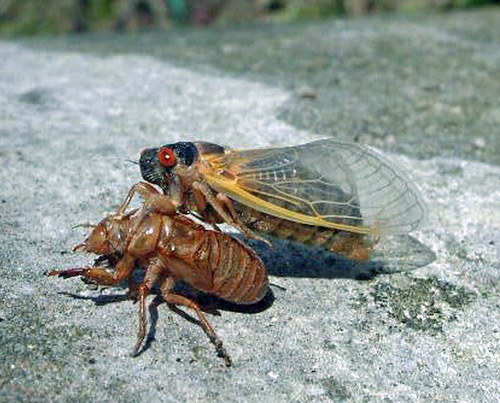
The buzz this spring has started, and some people may think it’s fodder for a new sci-fi movie. But this year’s spring brings a drama closer to home than you think - the pending emergence of brood II of the periodical cicada.
Cicadas are large, colorful, fly-like bugs with large eyes and tented wings. As the male cicadas sing their intense mating songs, some brand it as the sound of summer.
“Annual cicadas, known as dog-day cicadas in the U.S., are found throughout the world,” said Sandy Liebhold, a research entomologist with the U.S Forest Service’s Northern Research Station. “But the periodical cicadas emerge in massive groups known as “broods” once every 13 or 17 years and are completely unique to North America.”
There are 15 brood cycles, each designated by roman numerals. In the U.S., brood II is on track to crawl out of the ground very soon after a 17-year hiatus. They’ll emerge into one of the most densely populated urban/suburban forests in the world.
The mass emergence of brood II into the state and private forests of the tri-state area of eastern Connecticut, upstate New York, and northern New Jersey will sound a bit different than the familiar dog-day cicadas. Male cicadas use a special membrane to echo a series of clicks through its abdomen to attract females for reproduction. In chorus, the brood may sound like an insect-sized fleet of jets preparing for lift off, but the sound should be enjoyed as a wonderful spectacle of the mating ritual in the animal world.
Once mated, females will lay their eggs into the young twigs of trees and shrubs. The scars left behind, known in the scientific world as oviposition injury, can be quite striking and lead to “flagging” -- the dieback of small limbs.
Forest health aerial surveys conducted by the Massachusetts Department of Conservation and Recreation reported more than 8,700 acres with flagging left behind from the brood XIV emergence on Cape Cod in 2008. The scarring is mostly superficial but can have a mild impact on the growth of individual host trees. However, the mass emergence can benefit the longer, overall health of eastern forests.
After mating and laying eggs, adult cicadas die and fall to the forest floor. The nutrients released from the mass decay of the brood create a jolt of healthy nutrients available to forest organisms. Researchers have shown that this pulse of nutrition leads to an increase of beneficial microbes and nitrogen in soil, increased tree growth and more robust wildflowers.
Finally, after three to four weeks, the eggs hatch, the larvae wander under the forest floor where they feed on roots and start the process over again.
So, why every 13 to 17 years? Scientists have been pondering this ecological phenomenon for centuries.
“There is no doubt that by simultaneously emerging at those long intervals, periodical cicadas are able to saturate predators thereby maintaining high population levels,” said Liebhold.
Recent research also hypothesizes that periodical cicadas emerge when predator birds are at a lower density, suggesting that these amazing insects have queued into a larger ecological cycle – wow!
This is what we know but there is still a lot of mystery surrounding these time-travelling bugs. So if you find yourself one of the lucky ones to experience their visit, just sit back and enjoy this remarkable wonder of eastern forests.
Michael Bohne is an entomologist and forest health group leader with the U.S. Forest Service in Durham, N.H.

